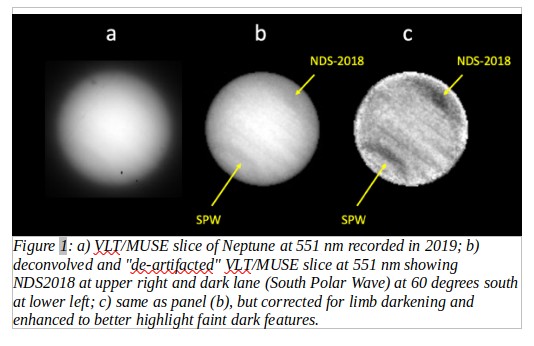Enhancing Observation Quality of Low Contrast Features of Ice Giants using MODIFIED CLEAN Algorithm and SSA-Based Artifact Detection
- 1Oxford University, Oxford, United Kingdom (jack.dobinson@physics.ox.ac.uk)
- 2Oxford University, Oxford, United Kingdom (patrick.irwin@physics.ox.ac.uk)
In 2018, observations revealed a dark spot on Neptune’s disc (NDS-2018) (Simon et. al., 2019), other darks spots have previously been observed (Hammel et. al. 1995) and their transient nature implies they are indicative of dynamic processes in Neptune’s atmosphere. However, observing these features from the ground poses substantial challenges. The point spread function (PSF) of ground based observations, even those using adaptive optics (AO), reduced the contrast between NDS-2018 and its brighter surrounding regions, complicating the detection and analysis of this phenomenon by causing “bleeding” of spectral information from the surrounding regions into NDS-2018 (Fig. 1). Traditional deconvolution techniques, such as the Lucy-Richardson (LR) algorithm (Richardson, 1972; Lucy, 1974; Wakker, 1988; Starck et. al., 2002), even with regularisation techniques e.g. Tikhonov regularization or methods to transform the problem into a more point-like deconvolution problem (Sromovsky et. al., 2001), were ineffective at improving the spatial resolution without introducing artifacts. Artifacts which, in the case of LR deconvolution for example, manifested as spurious bright and dark “mottling” with contrast levels similar to those of NDS-2018 and its adjacent disk, undermining the data quality and interpretability.
To address these challenges, we explored a modified version of the CLEAN algorithm, traditionally used in radio astronomy but seldom applied in visible or infrared observations (Keel, 1984). The CLEAN algorithm works by iteratively identifying and subtracting the strongest point sources in the data, effectively deconvolving the image (Högbom, 1974). The MODIFIED CLEAN (MC) algorithm adapts this approach to iteratively subtract extended bright regions, which eliminates much of the non-physical stippling seen when using the traditional CLEAN algorithm (Steer 1984). Like conventional methods, MC is sensitive to parameter choice, especially how the regions to be subtracted are selected. However, failure modes of MC are obviously non-physical, and automated tuning of parameters is possible. We provide a comprehensive overview of MC, including input, processing stages, and output examples, demonstrating its superior ability to enhance image quality and reveal details of NDS-2018 (Irwin et. al. 2022) and other Integral Field Unit (IFU) observations.
To support the deconvolution process, we also developed a Singular Spectrum Analysis (SSA) (Golyandina et. al., 2001; Golyandina et. al., 2013) based method to detect artifacts in the input data. This was required as Integral Field Unit (IFU) images, which capture data across hundreds to thousands of frequencies, present additional complexities in artifact detection. While small, stationary artifacts can often be managed through interpolation or median filtering, large or mobile artifacts, which shift unpredictably across frequencies, pose significant challenges. During deconvolution artifacts can introduce non-physical distortions and edge effects, corrupting the output far beyond their immediate vicinity. Manual identification is feasible for single images or stationary artifacts but becomes impractical for large IFU datasets with varying artifact positions. Thus, there is a need for automated techniques to identify and manage artifacts to ensure the integrity of deconvolution processes.

[Simon et. al., 2019] https://doi.org/10.1029/2019GL081961
[Hammel et. Al 1995] Hammel HB, Lockwood GW, Mills JR, Barnet CD. Hubble Space Telescope Imaging of Neptune's Cloud Structure in 1994. Science. 1995 Jun 23;268(5218):1740-2. doi: 10.1126/science.268.5218.1740. PMID: 17834994.
[Högbom 1974] Högbom, J.A. (1974). Aperture Synthesis with a Non-Regular Distribution of Interferometer Baselines, Astronomy and Astrophysics Supplement, 15, 417.
[Irwin et. al., 2022] https://doi.org/10.1029/2022JE007189
[Keel, 1984] https://doi.org/10.1086/132871
[Lucy 1974] Lucy, L. B. (1974). "An iterative technique for the rectification of observed distributions". Astron. J.,79 (6): 745–754.
[Richardson 1972] Richardson, W.H. (1972). "Bayesian-Based - Iterative Method of Image Restoration". J. Opt. Soc. America, 62(1), 55.
[Sromovsky et. al., 2001] https://doi.org/10.1006/icar.2000.6562
[Starck et. al., 2002] https://doi.org/10.1086/342606
[Steer 1984] Steer, D.G., et. al. (1984). Enhancements to the deconvolution algorithm ‘CLEAN’. A&S, 137, 159–165.
Wakker 1988] Wakker, B.P., & Schwarz, U.J. (1988) The Multi-Resolution CLEAN and its application to the short-spacing problem in interferometry. A&A, 200, 312–322.
[Golyandina et. al., 2001] Golyandina, N., Nekrutkin, V., & Zhigljavsky, A.A. (2001). Analysis of Time Series Structure - SSA and Related Techniques. Monographs on statistics and applied probability.
[Golyandina et. al.,2013] doi:10.48550/arXiv.1309.5050
How to cite: Dobinson, J. and Irwin, P.: Enhancing Observation Quality of Low Contrast Features of Ice Giants using MODIFIED CLEAN Algorithm and SSA-Based Artifact Detection, Europlanet Science Congress 2024, Berlin, Germany, 8–13 Sep 2024, EPSC2024-1130, https://doi.org/10.5194/epsc2024-1130, 2024.